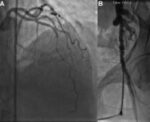Original title: Preinfarction Angina Reduces Infarct Size in ST-Elevation Myocardial Infarction Treated With Percutaneous Coronary Intervention Reference: Ronald Reiter et al. Circ Cardiovasc Interv. 2013;6:00-00. Ischemic preconditioning (IPC) is a phenomenon whereby transitory ischemia episodes protect the myocardium against a more prolonged episode. Until now, IPC has been the most effective approach to protect the myocardium. Pre infarction...
The FFR improves outcomes in daily practice as in randomized studies
Original title: Long-term outcomes of fractional flow reserve-guided vs. angiography-guided percutaneous coronary intervention in contemporary practice. Reference: Li J et al. Eur Heart J. 2013; Epub ahead of print Precision of the fractional flow reserve (FFR) to estimate the functional compromise of coronary stenosis and its ability to reduce events to decide PTCA, based on their outcome has...
Spontaneous coronary artery dissection (SCAD) is associated with fibro-muscular dysplasia in other territories
Original title: Spontaneous Coronary Artery Dissection. Prevalence of Predisposing Conditions Including Fibromuscular Dysplasia in a Tertiary Center Cohort Reference: Jacqueline Saw, et al. J Am Coll Cardiol Intv 2013;6:44 –52 Non atherosclerotic spontaneous coronary artery dissection (Non atherosclerotic SCAD) is a rare disease that is associated with acute myocardial infarction and sudden death. This condition is more common...
Intracoronary enalaprilat reduces periprocedural injury.
Original title: Intracoronary Enalaprilat to Reduce Microvascular Damage During Percutaneous Coronary Intervention (ProMicro) Study. Reference: Fabio Mangiacapra et al. J Am Coll Cardiol 2013. Article in press Angiotensin converting enzyme (ACE) inhibitors improve clinical outcomes in patients with coronary artery disease and improve epicardial flow in patients with acute ST-segment elevation. Beyond the long-term protective effect of oral...
Thrombus Aspiration is useful in AMI
Original title: A Prospective Randomized Trial of Trombectomy Versus No Thrombectomy in Patients With ST-Segment Elevation Myocardial Infarction and Thrombus-Rich Lesion. MUSTELA (MUltidevice Thrombectomy in Acute ST-Segment ELevation Acute Myocardial Infarction) Trial Reference: Marco De Carlo, et al. J Am Coll Cardiol Intv 2012;5:1223–30 The main objective during primary PCI is myocardial reperfusion, which is limited by distal...
Outpatient coronary angioplasty, is it possible?
Original title: Assessment of Clinical Outcomes related to Early Discharge alter elective Percutaneous Coronary Intervention: COED PCI Reference: Purushothaman Muthusamy MD, et al. Catheterization and Cardiovascular Intervention 81:6-13 (2013) The standard procedure in most institutions is that after angioplasty (PTCA) patients are discharged the next morning. There are some reports in which they were ambulatory but the safety...
Does the systematic use of clopidogrel reduce events prior to angioplasty?
Original title: Association of Clopidogrel Pretreatment with mortality, Cardiovascular events, and Major Bleeding among patients undergoing percutaneous coronary intervention. A systematic review and Mata-analysis. Reference: Anne Bellemain-Appaix, MD et al. for the ACTION group. The loading of clopidogrel before coronary angioplasty is an accepted practice by most clinical and interventional cardiologists but, nevertheless, it is only based on...
Self-expanding stents improve positioning in primary angioplasty
Original title: Self-Expanding Versus Balloon-Expandable Stents in Acute Myocardial Infarction: Results From the APPOSITION II Study Reference: Robert-Jan van Geuns et al. J Am Coll Cardiol Intv 2012;5:1209–19 Acute myocardial infarction is associated with vasoconstriction and thrombus occlusion. Resolution of these two points during the first hours after primary angioplasty can lead to poor extension and poor positioning...
Advances in Proximal Occlusion Devices for Carotid Angioplasty and Stenting
Original title: A Meta-Analysis of Proximal Oclusion Device Outcome in Carotid Artery Stenting Reference: Robert M Bersin, et al. Catheterization and Cardiovascular Intervention 80:1072-78 (2012) Carotid Angioplasty and Stenting (CAS) is considered a valid alternative to treat high risk patients. Embolic protection devices have been proved effective and currently there are two EPDs available: proximal occlusion and distal...
Are reversal flow cerebral protection devices useful in carotid angioplasty?
Original title: Prospective, Multicenter European Study of the GORE Flor Reversal System for Providing Neuroprotection During Carotid Artery Stenting Reference: Dimitrios Nikas, et, al.Catheterization and Cardiovascular Intervention 80:1060-1068 Cerebral protection systems (CPS) have proved useful in carotid angioplasty stenting (CAS), although it is not clear what the advantages are in respect to carotid endarterectomy, except in high risk...









